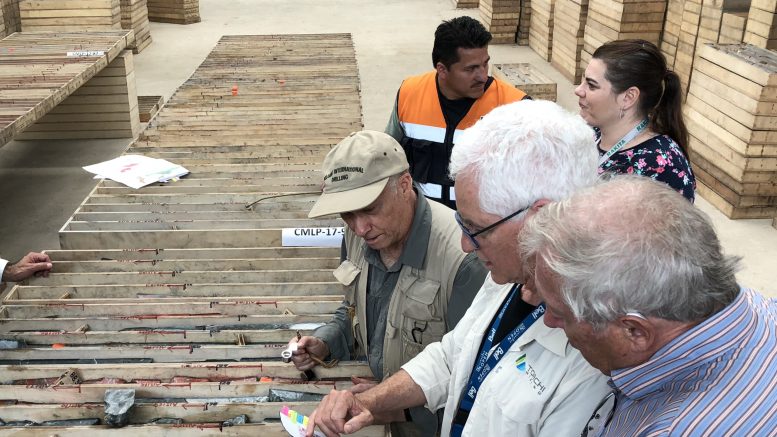Toachi Mining (TSXV: TIM) is trenching its Guatuza gold-copper target at its La Plata volcanogenic massive sulphide (VMS) project in Ecuador. It plans to drill Guatuza in the second half of the year, beginning with 5,000 metres exploring exposed VMS slabs to determine how far they extend underground.
Before that though, the company will finish a preliminary economic assessment (PEA) on La Plata it aims to release by the end of April 2019. It has completed metallurgical studies showing the project’s La Mina North and South deposits could produce copper-lead and zinc concentrates, with most of the gold going into the copper-lead concentrate.
“All this is the baseline for the PEA, because if your metallurgy doesn’t work, the rest of the PEA is kind of hard to justify,” Toachi president and CEO Alain Bureau says in an interview with The Northern Miner. “You want to set the story straight with the communities and with the government, and the PEA does that.”
Drilling by Toachi in 2017 led to a resource estimate the company tabled in September of that year. La Plata contains 1.9 million inferred tonnes grading 4.1 grams gold per tonne, 49.4 grams silver per tonne, 3.3% copper, 0.6% lead and 4.5% zinc, or 13.13 grams gold equivalent, for 245,000 oz. gold, 2.97 million oz. silver, 61,000 tonnes copper, 12,000 tonnes lead and 85,000 tonnes zinc, or 794,000 equivalent oz. gold.
La Plata’s resource is divided into two bodies: La Mina North and La Mina South, which are really one large deposit that has been split in two. La Mina South dropped 200 metres while La Mina North got lifted and tilted, so as to be almost vertical. As a result, mineralization at La Mina North extends from surface to 200 metres below surface, while mineralization La Mina South extends from 200 metres below surface to 400 metres below surface. Both zones remain open at depth.
“You actually have in the North block about 1 million tonnes, and in the South block about another 1 million tonnes of the high-grade material,” Bureau says.
Based on the way La Mina South is cut, the company thinks a third lens may lie south, 600 metres below the surface.
“Because it gets a little bit deep, we’ve decided to take the easy path and follow it to the north, where it is closer to surface,” Bureau says.
The company has more than 9 km of favourable geology along strike from La Plata, including the Guatuza gold-copper target, 150 metres north of La Mina North. Recent trenching highlights from Guatuza include 3 metres grading 5.4 grams gold, 71.2 grams silver, 2.1% copper, 3.2% lead and 10.9% zinc, as well as 6 metres at 2 grams gold, 32.5 grams silver, 2.3% copper, 0.8% lead and 2.6% zinc.
La Mina North was briefly mined from a small open pit, as well as underground workings from 1975 to 1981. Miners ran a small, 8-tonne-per-day open pit before eventually going underground, but only excavated 130,000 tonnes of material.
It was then drilled between 1996 and 1998 by Cambior and from 2006–2007 by Cornerstone Capital Resources. The two companies completed 8,600 and 5,900 metres and two resource estimates.
“Because this project has been mined back in the 70s, it’s a community that has already been exposed to mining,” Bureau says. “They understand the job that comes with it, but they understand also how a project is going to look.
“We also have the advantage of not having any indigenous community around the project. We don’t have to displace people, we don’t have to move big villages — we’re really in the zone where it’s mostly agriculture and cattle.”
Toachi is earning a 60% interest in the project from a private Ecuadorean company. The company has spent US$4 million on exploration and made staged payments totalling US$1 million. It will complete another US$1-million payment shortly.
“We’re about to make the 60%,” Bureau says. “We haven’t done it yet, but it’s a question of days and weeks.”
To increase its ownership at La Plata to 65%, the company will table a feasibility study for the project. It can increase its ownership to 75% by raising the financing to build the project. If the project costs less than US$60 million, Toachi earns another 5% interest. If it raises more than US$60 million, it earns an extra 10% interest.
“Thirty-three percent of the raw value comes from copper and 36% from gold,” Bureau explains. “What sets us apart, really, is the grade of the project, and also that we have an excellent location, as we’re the closest project to Quito.”
La Plata sits 100 km southwest of Quito, Ecuador’s capital — 85 km of which includes a paved road. Power lines run across the concession, with a hydroelectric power plant 5 km away.
“In terms of location, it’s a prime place to be,” Bureau says. “In recent years the government has rebuilt all the major highways across the country, and there’s actually a highway that goes right beside our concession, so there’s only 15 km of gravel road.”
Shares of Toachi Mining are trading at 9¢ in a 52-week range of 6¢ to 20¢. The company has an $8-million market capitalization.
“Ecuador has been recognized in the few past years as the new place to be if you’re looking for copper, and if you’re looking for gold,” Bureau says. “The government is behind the mining industry — they’re really pushing hard to try to attract more investment.”


Dr.Duncan Derry carried out the first drilling at La Plata to trace the VMS stratigraphy north of Guatuza, based on suspected analogies to Kidd Creek and also to Kuroko deposits. The Hole intersected 22m at 1.8% Cu .Difficulties such as non-wireline drilling in a terrain covered by recent volcanic ash were overcome.Ian Thompson,Derry’s Field Geologist .Client was Triangle Conduit &Cable from New Jersey